In the Moment:
Michael Frye's Landscape Photography Blog
by Michael Frye | Nov 15, 2015 | Yosemite Photo Conditions
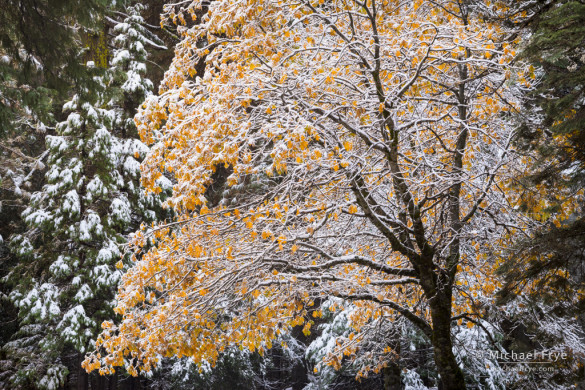
Snow-covered California black oak, late autumn, Yosemite, Tuesday morning
I’m in Dallas today teaching a Lightroom workshop for the Sun to Moon Gallery. We have a nice group of people and we’re having a great time, but meanwhile, back in Yosemite, another storm is arriving. I won’t get to photograph this one, but did get to photograph the previous one last Monday and Tuesday.
That storm featured a brief, misty clearing on Monday morning, a dusting of snow on Monday night, and a couple of surprises. It began on Sunday night, but early Monday morning the satellite and radar images showed that there might be a break around sunrise before more precipitation arrived that afternoon. So I drove up to Tunnel View early, and sure enough, it did clear. It wasn’t the most colorful sunrise, but there was plenty of beautiful mist, as you can see in this photograph:
(more…)
by Michael Frye | Nov 13, 2015 | Announcements, Digital Darkroom
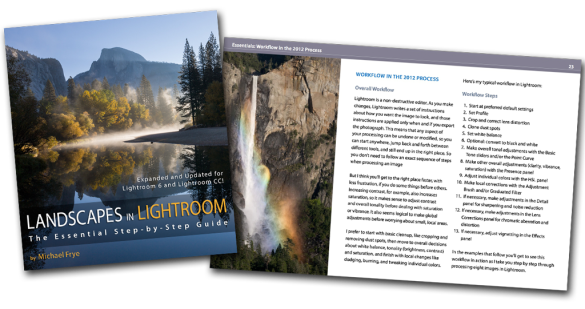
A quick reminder that the price for my Landscapes in Lightroom ebook and video package will go up on Sunday (at midnight Pacific time) from $14.95 to $27.00. This is your last chance to get the new edition at the old price! The new version has been updated for Lightroom 6 and Lightroom CC, and includes eight step-by-step examples, plus ten video tutorials. Click the Add to Cart button below, or visit this page for more information.
Landscapes in Lightroom: The Essential Step-by-Step Guide
PDF ebook plus video tutorials
103 double-page spreads
14.95 until Sunday, November 15th, after which the price goes up to 27.00
FAQ
Purchase from the Eduction Center
(more…)
by Michael Frye | Nov 8, 2015 | Travels and Stories
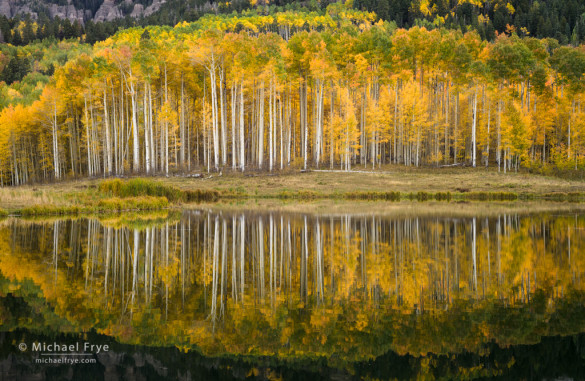
Aspens and reflections, Uncompahgre NF, Colorado. This small, remote pond had a beautiful stand of aspens growing next to it. The trunks remind me of a baleen whale’s teeth.
As I said in this recent post, I had many opportunities to photograph aspens as part of a larger landscape this fall. But of course I photographed more intimate scenes as well, and I’ve included a selection of smaller-scale aspen photographs from Colorado here. Some of these images actually encompass a large geographic area, but I made the somewhat arbitrary distinction of defining an intimate landscape as anything that didn’t include sky.
On our first autumn visit to Colorado last year we split our time between the Kebler Pass/McClure Pass area and the San Juan Mountains. This year we spent the whole time in the San Juans, which allowed us to get to know this area better. There’s always something to be said for that. As you become more familiar with a place, you discover some of the lesser-known locations. You also start to learn the weather patterns, and know where to go at sunrise or sunset when there might be interesting clouds.
(more…)
by Michael Frye | Nov 6, 2015 | Announcements
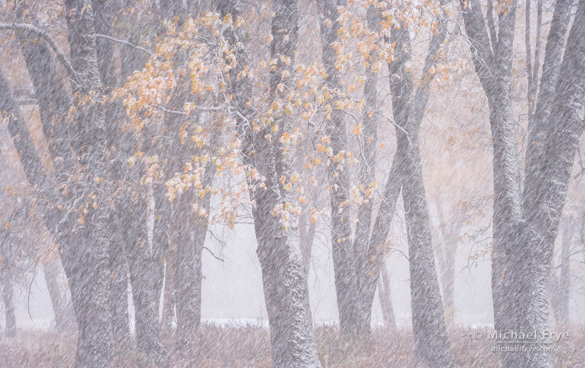
Oaks in an autumn snowstorm, Yosemite; from the 2013 Yosemite Renaissance exhibit
This is a quick post to let you know that the deadline for entering the 31st annual Yosemite Renaissance competition and exhibit is approaching on November 15th. You can find out all the details and enter online here.
This is a great organization and competition, and the opening reception (next February 26th) is always a really fun event. The competition is “intended to encourage diverse artistic interpretations of Yosemite.” I’ve been honored to have my photographs accepted into the Yosemite Renaissance exhibit a number of times, and always felt I was in good company with many wonderful artists in each show. The photograph above was in the 2013 exhibit.
(more…)
by Michael Frye | Nov 5, 2015 | Yosemite Photo Conditions
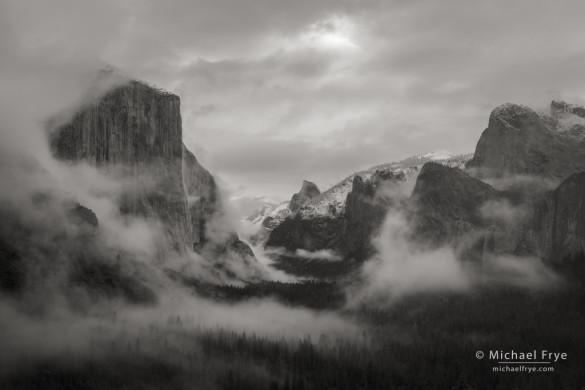
Clouds and mist from Tunnel View, Tuesday morning
It’s nice to see the Yosemite high country covered in snow on the Sentinel Dome webcam – an uncommon sight in recent years. On Monday a large, winter-like storm reached California, dropping over two-and-a-half inches of rain in Yosemite Valley, and from one to two feet of snow at higher elevations. The winter wet season is off to a good start.
I’m not celebrating too much yet, however, because I remember this happening before. During the last four water-starved winters several large, early-season storms have created initial optimism, only to be followed by months of sunny skies. Let’s hope that this is just the first of many big storms to arrive this winter.
(more…)
by Michael Frye | Nov 3, 2015 | Digital Darkroom
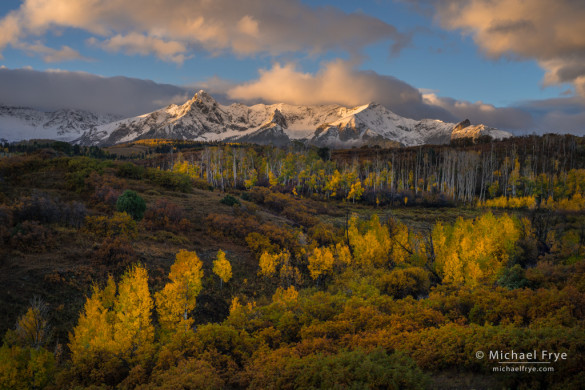
Autumn sunrise over the Sneffels Range from the Dallas Divide, CO, USA
As I wrote in my last post, it can be challenging to process high-contrast scenes with important, colorful subjects in the shade – like aspens. You need to lighten the shadows even more than normal to bring out the color, and it’s hard to do that in a natural-looking way, while keeping contrast and depth.
This photograph is a good example. It’s from the Dallas Divide, one of Colorado’s iconic fall locations. Fresh snow on the peaks added interest, but also created more contrast. The morning sun lit the peaks and clouds, but I knew it would be awhile before that light reached the aspens in the foreground, and by that time the color in the sky would be gone. I bracketed three exposures, each one stop apart, in case I needed to blend them together later. But I didn’t need to blend; the final image was processed in Lightroom with just one frame.
(more…)
by Michael Frye | Nov 1, 2015 | Digital Darkroom, Light and Weather
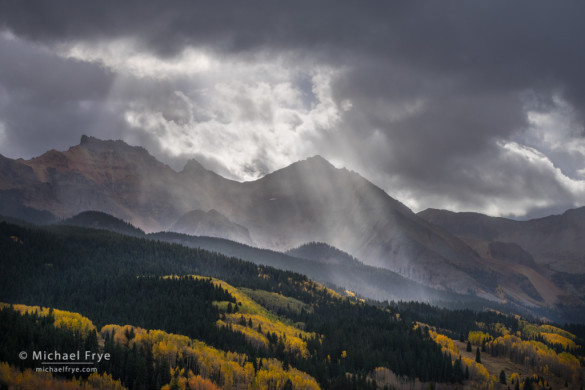
Sunbeams, San Juan Mountains, Colorado. Driving over Lizard Head Pass we came around a bend and spotted these sunbeams coming through the clouds. Claudia found a place to pull over, and I scrambled to set up my camera as quickly as possible. Wind was blowing rain right toward the camera, so it was a challenge to keep water drops off the lens. I stayed for at least 20 minutes capturing images of the sunbeams as they moved and changed, but this was the very first frame. A challenging photo to process!
With their straight, white trunks and colorful leaves, aspens are great subjects for intimate landscapes. But in both Colorado and the eastern Sierra this fall we had lots of interesting weather, with great clouds, which created many opportunities to capture images of aspens as part of a larger landscape, with mountains in the background. I’ve posted a couple of these photographs already (here and here), but I’ve included a few more in this post.
These images were sometimes challenging to process. Often the aspens were in the shade, with sunlit, sometimes snow-covered peaks above, creating a lot of contrast. Yet all of these images were processed in Lightroom, with just one Raw file – no exposure blending or HDR. I used Lightroom’s wonderful Highlights and Shadows tools, plus some dodging and burning with the Adjustment Brush.
(more…)
by Michael Frye | Oct 29, 2015 | Yosemite Photo Conditions
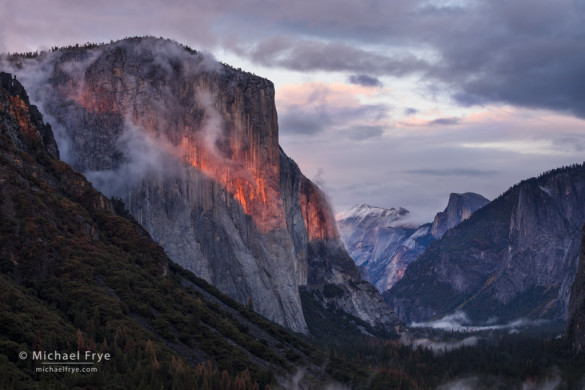
Sunset light, Tunnel View, yesterday evening
Some interesting weather passed through the Sierra Nevada yesterday. It so happened that I had an errand to run in Yosemite Valley, which gave me an excuse (as if I needed one) to go up there and check on the weather. After taking care of the errand, Claudia and I ended up at Tunnel View, where we waited out a thunderstorm. I tried to take a nap in the car, but was rudely awakened several times by loud claps of thunder. After the rain stopped I went out to the viewpoint and waited for the sun to break through, joined by a number of other photographers, including some friends and acquaintances. Tunnel View is, by virtue of its popularity, the social gathering place for photographers in Yosemite.
Finally, just before sunset, the sun did break through and light El Capitan (see the photograph above). It’s funny how all those photographers can suddenly become quiet as they concentrate on composition and camera settings.
(more…)
by Michael Frye | Oct 25, 2015 | Yosemite Photo Conditions
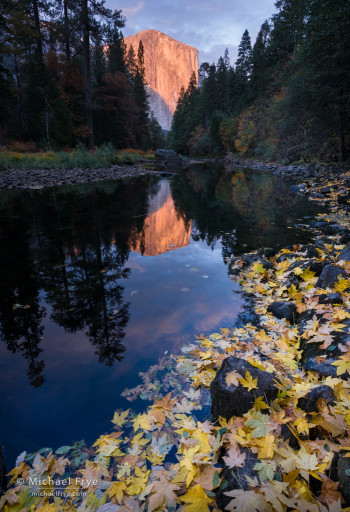
El Capitan and the Merced River, autumn, Yosemite Valley. This photograph from 2006 shows big-leaf maple leaves covering the foreground shoreline.
On my way home Thursday I drove the loop around Yosemite Valley to check on the fall color progression. The first thing that struck me was the cottonwoods, which have all dropped their leaves without turning yellow. Is this a sign of the drought? Maybe, but I saw the same thing happen in 2011, after one of the wettest winters and springs on record for Yosemite Valley. There are a lot of factors that affect fall color, so it’s hard to pinpoint one cause.
Some of the black oak leaves also seem to be turning brown. I’d say half of the oaks look fine (though still mostly green), and half appear to be wilting.
On the other hand, the big-leaf maples and dogwoods look pretty normal, though they’re turning late. Many maples sport a few brown leaves, but that’s actually pretty typical. The rest of the leaves are either healthy green or starting to turn yellow, and once they all turn yellow you won’t notice the brown leaves. Most of the dogwoods look quite normal overall, though they’re turning late.
(more…)
by Michael Frye | Oct 22, 2015 | Yosemite Photo Conditions

Aspens along a creek in the eastern Sierra Nevada, from last Friday
After nearly a month on the road in Colorado and the eastern Sierra, Claudia and I are heading home today. But before making the drive I thought I’d post a brief report about fall color on the east side.
Colder weather and wind this week have caused many leaves at higher elevations to drop off, yet there are some beautiful patches of color at lower elevations, along with many still-green aspens. Lower Lundy Canyon (up to the end of the dirt road) looks really nice right now, with about 70 percent of the trees turning, 20 percent green, and 10 percent bare. The June Lake Loop from Grant to Silver lakes has plenty of color, but is still only perhaps 50 percent yellow and orange, with 50 percent green. Lee Vining Canyon is maybe 60 or 70 percent green, with the rest either yellow, bare, or brown. Up a little higher, Conway Summit has some large bare patches, but a few groves there are still quite colorful.
(more…)


















